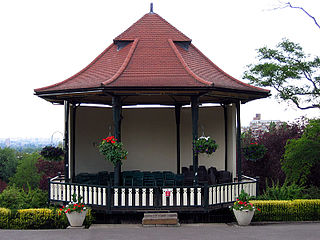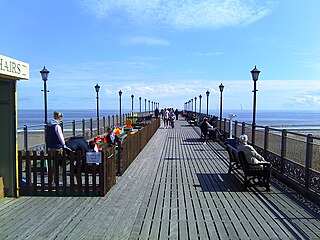
Norfolk is a county in East Anglia in England. It borders Lincolnshire to the northwest, Cambridgeshire to the west and southwest, and Suffolk to the south. Its northern and eastern boundaries are the North Sea and to the northwest, The Wash. The county town is the city of Norwich. With an area of 2,074 square miles (5,370 km2) and a population of 859,400, Norfolk is a largely rural county with a population density of 401 per square mile. Of the county's population, 40% live in four major built up areas: Norwich (213,000), Great Yarmouth (63,000), King's Lynn (46,000), and Thetford (25,000).

Hunstanton is a seaside town in Norfolk, England, which had a population of 4,229 at the 2011 Census. It faces west across The Wash, making it one of the few places on the east coast where the sun sets over the sea. Hunstanton lies 102 miles (164 km) north-north-east of London and 40 miles (64 km) north-west of Norwich.

Cromer is a coastal town and civil parish on the north coast of the English county of Norfolk. It is approximately 23 miles (37 km) north of the county town of Norwich, 116 miles (187 km) north-northeast of London and 4 miles (6.4 km) east of Sheringham on the North Sea coastline. The local government authorities are North Norfolk District Council, whose headquarters is on Holt Road in the town, and Norfolk County Council, based in Norwich. The civil parish has an area of 4.66 km2 (1.80 sq mi) and at the 2011 census had a population of 7,683.

A bandstand is a circular, semicircular or polygonal structure set in a park, garden, pier, or indoor space, designed to accommodate musical bands performing concerts. A simple construction, it both creates an ornamental focal point and also serves acoustic requirements while providing shelter for the changeable weather, if outdoors. In form bandstands resemble ornamental European garden gazebos modeled on outdoor open–sided pavilions found in Asian countries from early times.

The West Pier is a pier in Brighton, England. It was designed by Eugenius Birch and opened in 1866. It was the first pier to be Grade I listed in England & Wales but has become increasingly derelict since its closure to the public in 1975. As of 2020, only a partial metal framework remains.

Cromer Pier is a Grade II listed seaside pier in the civil parish of Cromer on the north coast of the English county of Norfolk, 25 miles (40 km) due north of the city of Norwich in the United Kingdom. The pier is the home of the Cromer Lifeboat Station and the Pavilion Theatre.

Southwold Pier is a pier in the coastal town of Southwold in the English county of Suffolk. It is on the northern edge of the town and extends 190 metres (620 ft) into the North Sea.

Llandudno Pier Pavilion Theatre was a Victorian seaside theatre in the holiday resort of Llandudno in North Wales, UK.

The Victoria Pier was a pier in the seaside resort of Colwyn Bay, Wales. Despite dismantlement since May 2018, much of the metalwork remains and retains the legal status of a grade-II listed structure. Plans for a partial re-build in 2019 have been made by the pier's owner, Conwy County Borough Council.

Wellington Pier is located at the seaside town of Great Yarmouth in the English county of Norfolk.

Sandown Pier is a pleasure pier in Sandown, Isle of Wight, England.

Weymouth Pier is a peninsula between Weymouth Harbour and Weymouth Beach, in Dorset, England. It was intended to extend Weymouth's esplanade, and consists of a theatre, Weymouth Pavilion; pleasure pier; car parking and a cross-channel ferry terminal. The entire site underwent redevelopment to include new facilities for the 2012 Olympic Games, including the Weymouth Sea Life Tower.
Richard Condon, was an impresario and theatre manager.

Clacton Pier is a pier located in the seaside resort town of Clacton-on-Sea in England. It was named Pier of the Year in 2020 by the National Piers Society. The pier hosts rides, ten-pin bowling, arcades, a seqaurium, golf and a soft-play centre – as well as numerous food, drink and retail outlets.

Herne Bay Pier was the third pier to be built at Herne Bay, Kent for passenger steamers. It was notable for its length of 3,787 feet (1,154 m) and for appearing in the opening sequence of Ken Russell's first feature film French Dressing. It was destroyed in a storm in 1978 and dismantled in 1980, leaving a stub with sports centre at the landward end, and part of the landing stage isolated at sea. It was preceded by two piers: a wooden deep-sea pier designed by Thomas Rhodes, assistant of Thomas Telford, and a second shorter iron version by Wilkinson & Smith.

Skegness Pier is a pleasure pier in Skegness, England. Opened in June 1881, it was at the time the fourth longest in England, originally stretching a length of 562 m (1,844 ft). When originally built, it was a T-shaped pier with a saloon/concert hall at the pier head. Steamboat trips ran from the pier to Norfolk until 1910.

St Anne's Pier is a Victorian era pleasure pier in the English seaside resort of St Anne's-on-the-Sea, Lancashire. It lies on the estuary of the River Ribble. The pier, designed by A. Dowson, was completed in 1885 and was one of the earliest public buildings in St Anne's, a 19th-century planned town. The pier was originally intended to be a sedate promenading venue for the resort's visitors, but attractions were later added. Changes made to the estuary channels to improve access to Preston Dock left the pier on dry land and ended its steamer services to Blackpool and Liverpool.

Penarth Pier is a Victorian era pier in the town of Penarth, Vale of Glamorgan, South Wales. The pier was opened in 1898 and was a popular attraction to seaside-goers at the time, who also enjoyed trips on pleasure steamers that operated from the pier. It has on several occasions been damaged by vessels colliding with the structure and in 1931, a fire broke out in one of the pavilions. This wooden pavilion was never replaced, but a concrete pavilion has been used over the years as a concert hall, ballroom, cinema and for other purposes. It is currently home to the Penarth Pier Pavilion.

Britannia Pier is a pier located at the seaside town of Great Yarmouth in the English county of Norfolk.

Redcar Pier was a Victorian pleasure and landing pier constructed on The Esplanade in the seaside town of Redcar on the north east coast of Yorkshire, England.




















